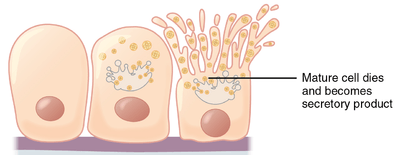Holocrine
|
Exocrine Secretion |
| Merocrine or eccrine – by exocytosis |
| Apocrine – by membrane budding (loss of cytoplasm) |
| Holocrine – by membrane rupture |

Holocrine secretion
Holocrine is a term used to classify the mode of secretion in exocrine glands in the study of histology. Holocrine secretions are produced in the cytoplasm of the cell and released by the rupture of the plasma membrane, which destroys the cell and results in the secretion of the product into the lumen.
Holocrine secretion is the most damaging type of secretion, with merocrine secretion being the least damaging and apocrine secretion falling in between.
Examples of holocrine glands include the sebaceous glands of the skin and the meibomian glands of the eyelid. The sebaceous gland is an example of a holocrine gland because its product of secretion (sebum) is released with remnants of dead cells.[1]
References
- ↑ Victor Eroschenko, diFiore's Atlas of Histology with functional correlations, Lippincot Williams and Wilkins, 10th edition, 2005. p. 41
External links
This article is issued from Wikipedia - version of the 11/19/2016. The text is available under the Creative Commons Attribution/Share Alike but additional terms may apply for the media files.